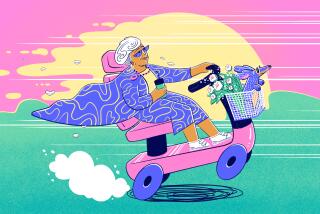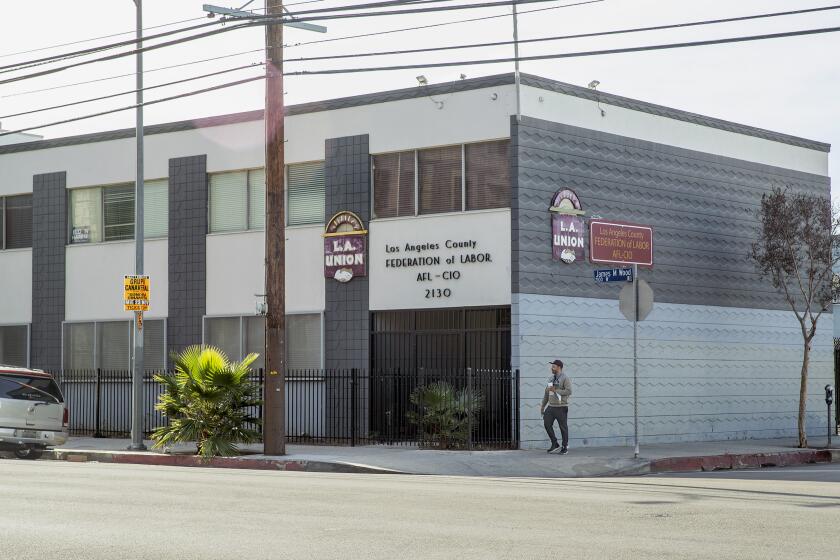Column: Admitting our own quirks may lead us to accept others
On her regular visit to her neighborhood Starbucks one morning, the manager greeted Tina Levine with a message that couldn’t help but hurt.
“He shared with me that customers complained about me being in the store,” Levine said. “I couldn’t recall what exactly I had done wrong. Some inappropriate conversation I had struck up with a patron? Was I a bit too hyper in line?
“Whatever it was, it made people uncomfortable.... They thought I was a little off.”
Levine is a little off — and she’s the first to admit it.
“I hit the mental illness trifecta,” she told me in an email that she titled “A Coming Out Story.” Levine, 60, was diagnosed years ago with depression, generalized anxiety disorder and obsessive-compulsive disorder.
She has trouble with boundaries, can’t read social cues, gets fixated on irrational fears. When she’s feeling good, she might seem manic. When she’s feeling bad, she can come off as obnoxious and rude. Some days she feels so listless, she can’t get out of bed.
Levine holds three university degrees — a bachelor’s in Spanish literature, and masters from NYU and USC — and worked intermittently as a legal secretary and writer for the game shows “Jeopardy” and “Hollywood Squares.” But she hasn’t held a job since 2006. “I collapse under pressure,” she said.
For now, she gets by on federal disability payments, because she’s considered too mentally unstable to support herself. That’s been a financial relief, but an emotional blow:
“If the government thinks you’re nuts,” she said, “how much hope can there be?”
::
Levine warned me that she tends to make strangers uncomfortable. She shares too much, gives too freely, probes too pointedly.
But during our two-hour chat over breakfast, I wasn’t nervous at all. I found Levine insightful, interesting and unwittingly charming — a woman who, in an earlier era, might be simply considered eccentric, not mentally disordered.
She credits a medical regimen that has begun to even out her moods. A combination of medications and therapy is helping rein in her worst impulses and banish ruinous thoughts.
“For years I resisted taking meds,” she said. She tried acupuncture, mental exercises, natural healing. “I thought if only I exercised [and] ate right … I could pull myself out of depression, anxiety and OCD.”
Like many people with mental illness, it took a long time for Levine to get the help she needed. More than 60 million Americans — one in four adults — are believed to experience signs of mental illness in any given year. But the spectrum of symptoms and conditions is so broad that treatment is trial-and-error.
Levine first saw a therapist in college, when she was seized with irrational fears that she’d written inappropriate words — curses, sexual references, racial slurs — in essays and exams. “I walked around in a perpetual state of anxiety,” she said.
So she resorted to making carbon paper copies and asking a friend to proofread her work. She was too embarrassed to explain what she was worried about.
Since then, mental illness has constrained Levine’s life in odd and routine ways.
She was once compelled to eat the same thing — noodles and cottage cheese — at every meal for 45 days. She sometimes avoids greeting people she knows, afraid she’ll say the wrong thing. Before she leaves home, she has to check to make sure she hasn’t left the stove on or the water running, again and again and again.
Levine understands how irrational that must seem to mentally healthy people. “Sometimes even I feel my behavior is self-indulgent,” she said.
There are ways she’s found to cope: She takes a picture of the stove before she leaves home, to check and reassure herself that she hasn’t left a burner on. She’s adopted three cats, so she can’t pull the covers over her head everyday and refuse to get out of bed.
She wants us to know that people like her — privately battling disorders that exhaust or terrify them — are doing the best they can. And the stigma that mental illness carries only makes it harder.
“Try not to judge me because how I act doesn’t jibe with your beliefs about how a person should behave,” she said.
“I’m trying to function as ‘normally’ as possible, whatever that is.... But I sometimes feel that my ‘best’ isn’t good enough and never will be.”
::
Levine can’t afford to let the incident at Starbucks throw her. But it does embarrass her to imagine those coffee shop patrons in Long Beach snickering about behavior that she thought was social and they considered bizarre.
Our conversation made me feel close to Levine in unexpected ways. I may not be saddled with her disorders, but we have a lot in common.
We both feel like failures when items on our to-do lists remain perpetually undone. Like Levine, I get so anxious when I’m stuck in traffic, I feel like my head will explode. And we both have watched strangers’ eyes glaze over as we babble on in line at the market.
But I have the luxury of considering those foibles, not signs of mental sickness. For Levine, life is a roller coaster. For me, it’s a balancing act.
There’s a thin line, after all, between being a perfectionist and being obsessive, between being amusing and being annoying, between proffering an opinion and browbeating a stranger.
Maybe we’d all be better off if we more openly acknowledged our flaws and eccentricities, instead of trying to steer clear of people we find uncomfortably odd.
sandy.banks@latimes.com
Twitter: @SandyBanksLAT
More to Read
Start your day right
Sign up for Essential California for news, features and recommendations from the L.A. Times and beyond in your inbox six days a week.
You may occasionally receive promotional content from the Los Angeles Times.







